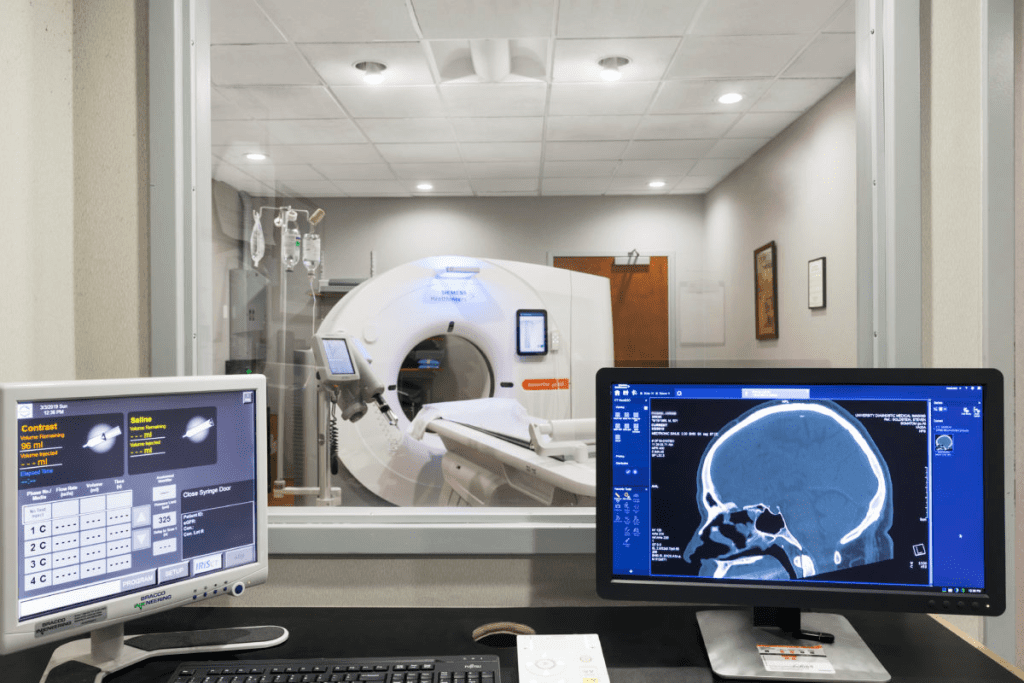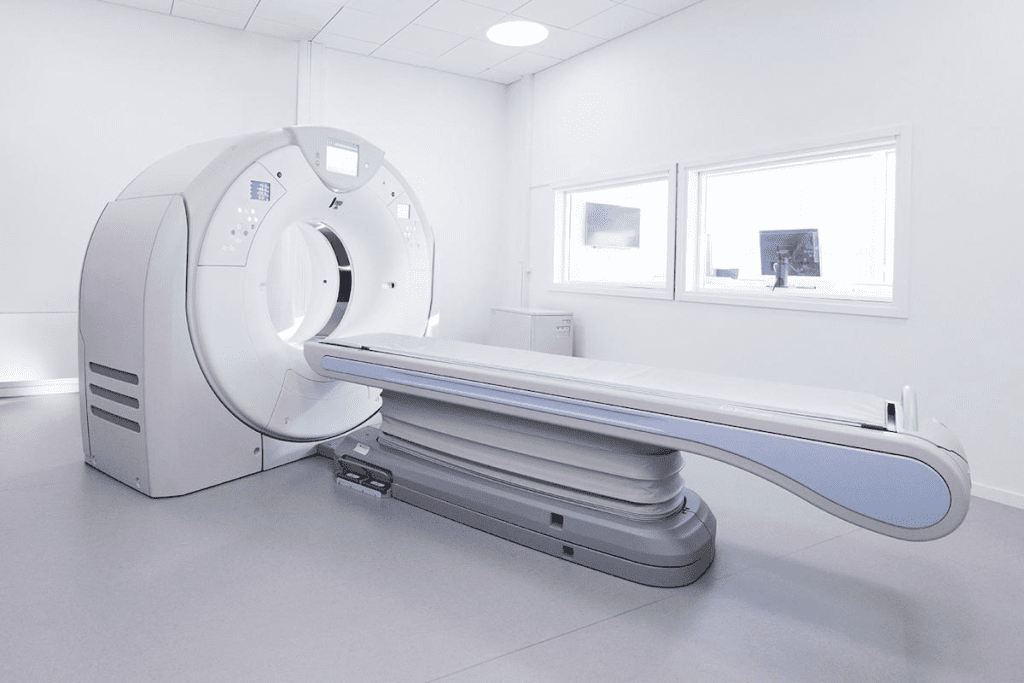Last Updated on November 25, 2025 by
Medical imaging is key in finding and treating health issues. At LIV Hospital, we use top-notch imaging to get accurate diagnoses and treatment plans. Two main imaging methods are CT scans and urograms.
A CT scan uses X-rays to make detailed images of the body. It helps find many health problems. A urogram, often a CT urogram, looks at the urinary system. It checks the kidneys, ureters, and bladder for diseases.

Knowing the difference between these imaging methods is important. We aim to give top care and help our patients understand their diagnosis and treatment.

Computed Tomography (CT) scans have changed medical imaging a lot. They give detailed pictures of the body’s inside. We’ll look at how they work, their types, and how they help in medical diagnosis.
CT scans use X-rays and computers to make detailed images. The patient lies on a table that moves into a machine shaped like a doughnut. The machine spins around the patient, sending out X-rays.
These X-rays are caught by sensors and sent to a computer. The computer then makes the images.
“The use of CT scans has become widespread due to their ability to rapidly diagnose conditions such as trauma, infection, or tumors,” as noted by medical professionals. This technology has significantly improved diagnostic accuracy and patient outcomes.
There are many types of CT scans, like standard CT scans, CT angiography, and CT perfusion scans. Each one is used for different things. For example, CT angiography checks for vascular diseases, while CT perfusion scans look at blood flow to organs.
Standard CT imaging is fast, versatile, and shows detailed pictures of the body’s inside. But, it also has downsides, like radiation exposure. We consider these points when deciding if a CT scan is right for a patient.
Knowing how CT scans work helps us see their importance in healthcare. By using CT scans’ strengths and knowing their weaknesses, doctors can give accurate diagnoses and effective treatments.
CT urography is a key tool for checking the urinary system. It gives us detailed images of the kidneys, ureters, and bladder. This helps us spot different problems.
A CT urogram is a special CT scan for the urinary system. It aims to show the urinary tract clearly. This helps us find tumors, stones, and other issues.
The CT urogram with contrast is especially helpful. It makes the urinary system and any problems stand out more.

Contrast media are crucial in CT urography. They help us see the urinary tract and any problems more clearly. The contrast is given through an IV and is safe for most people.
Doctors suggest a CT urogram for urinary tract issues. It’s great for finding tumors and bladder problems. It’s also used for patients with blood in their urine or other symptoms.
CT urography gives us a full view of the urinary system. This helps us catch diseases early. It improves treatment and outcomes for patients.
Understanding the differences between a standard CT scan and a CT urogram is key to diagnosing urinary tract issues. Both use computed tomography technology but serve different purposes. This is important for accurate diagnosis.
Standard CT scans can see many parts of the body, like the abdomen and pelvis. But they might not show the urinary tract as clearly as a CT urogram does. A CT urogram focuses on the urinary system, giving a detailed look at the kidneys, ureters, and bladder.
A CT urogram is great for spotting problems like kidney stones, tumors, and other issues in the urinary system. It can show the size and location of stones more clearly than other scans.
One big difference is contrast media use. CT urograms use intravenous contrast to make the urinary tract stand out. This contrast makes it easier to see problems in the urinary system.
A standard CT scan and a CT urogram give different kinds of information. A standard CT scan can show injuries or diseases in many parts of the body. But a CT urogram focuses on the urinary tract, giving detailed info on the kidneys, ureters, and bladder.
A bladder CT scan or CT cystogram is great for checking bladder problems like tumors or diverticula. This is very helpful for urologists planning treatments.
Both CT scans and CT urograms use radiation. The amount depends on the imaging protocol and the body area scanned. Healthcare providers must weigh the benefits against the risks of radiation.
We think carefully about radiation exposure when choosing between a standard CT scan and a CT urogram. We make sure the benefits are worth the risks for our patients.
CT urography is a key tool for checking the urinary tract. It’s very good at finding problems. This helps doctors diagnose and treat many urological issues better.
CT urography is great at spotting urinary tract issues. It’s more accurate than older methods. This is because it uses contrast to show the urinary tract clearly.
CT urography beats traditional methods in many ways. It gives clearer images and finds more problems. Plus, it’s quicker and less invasive.
CT urography is especially useful for common issues like kidney stones and tumors. It gives a full view of the urinary tract. This makes it essential in urology today.
In short, CT urography is a top choice for checking the urinary tract. It’s accurate and useful for many urological conditions.
When getting ready for CT scans or urograms, there are many things to think about. Knowing these can make you feel less anxious and make the process easier.
Getting ready for a CT scan or urogram means following certain rules. You might need to eat differently or get contrast media. For a CT urogram, drinking water is often required to get clear images.
Key preparation steps include:
During a CT scan or urogram, you’ll lie on a table that moves into a CT scanner. The whole thing usually takes just a few minutes. For a CT urogram, more scans might be done after getting contrast media.
The price of a CT scan or urogram can change based on where you are and who you see. Most of the time, insurance covers these tests if they’re needed. It’s a good idea to talk to your insurance to know what they’ll pay for.
If you’re worried about radiation, there are other tests like MR urography. They don’t use radiation and work just as well. Talking to your doctor about these options can help you choose the best test.
Understanding what you need to do before, during, and after the test can make things easier. Knowing about costs and insurance can also help you feel more in control.
Understanding the differences between CT scans and urograms is key when checking the urinary tract. We’ve looked at how each imaging method works, its benefits, and its limits.
CT urograms are great for detailed views and accurate diagnoses of the urinary tract. Healthcare providers can pick the best test for their patients by considering their needs and the study’s features.
CT urography is excellent for spotting urinary tract issues because it’s very sensitive and specific. The choice between a CT scan and a urogram depends on what the doctor needs to see and the patient’s situation.
Knowing the good and bad of each imaging method helps us give patients the best care for their urinary tract problems.
A CT scan shows cross-sections of the body. A CT urogram focuses on the urinary tract. It uses contrast media to see the kidneys, ureters, and bladder.
A CT urogram helps find diseases in the urinary tract. It looks for tumors, stones, and other problems. It gives clear images of the kidneys, ureters, and bladder.
A CT urogram uses contrast media to highlight the urinary tract. This helps doctors see and diagnose conditions in this system.
Contrast media make the urinary tract visible. It helps doctors find and diagnose diseases and abnormalities.
To prepare for a CT urogram, arrive on time at the imaging facility. Complete any necessary paperwork. Follow your healthcare provider’s instructions, like fasting or staying hydrated.
CT urography is more sensitive and specific than traditional excretory urography. It’s a better tool for diagnosing urinary tract problems.
Yes, MR urography is a radiation-free alternative. It has similar diagnostic performance for certain conditions.
The cost of a CT urogram varies by facility and location. Many insurance plans in the United States cover it. Check with your insurance provider for details.
Standard CT scans may not show the urinary tract as well as a CT urogram. This is especially true without contrast media tailored for urography.
Both CT scans and CT urograms involve radiation. The dose can vary. Your healthcare provider will consider the benefits against the risks of radiation.
Subscribe to our e-newsletter to stay informed about the latest innovations in the world of health and exclusive offers!